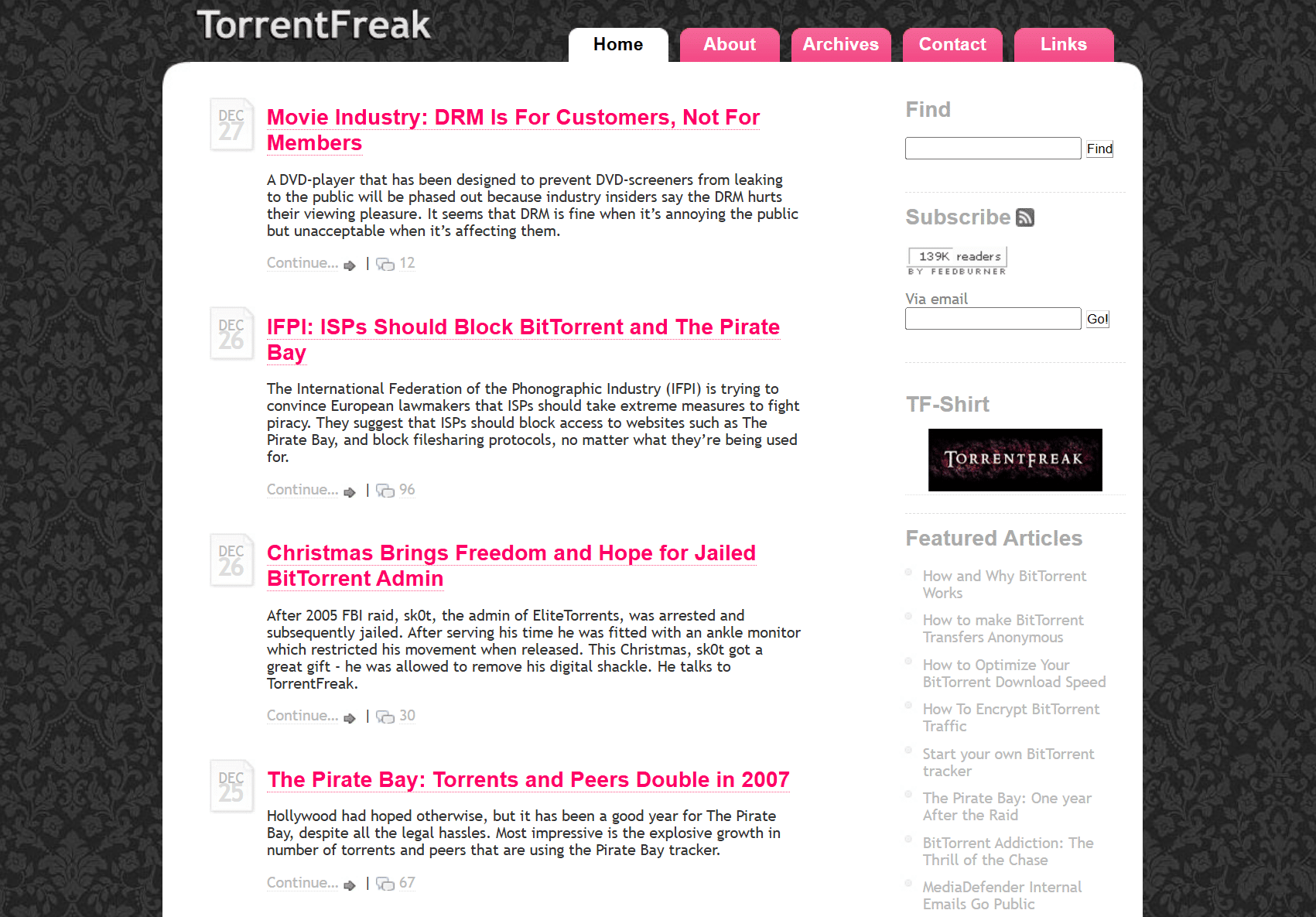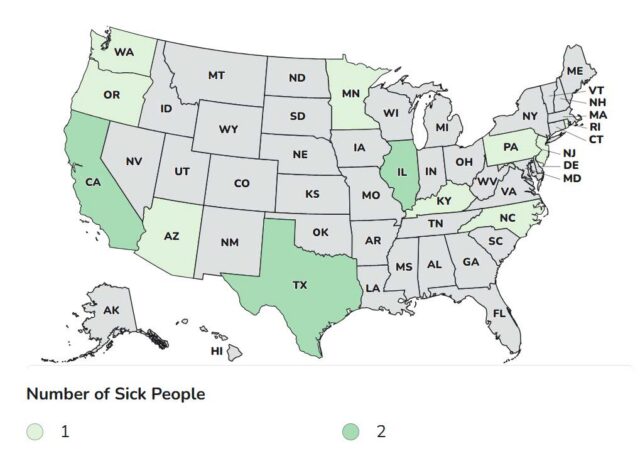Today marks TorrentFreak’s 20th anniversary. After covering a changing piracy and copyright landscape for two decades, I’d like to take a moment to reflect and look forward. The site has accomplished more than I ever imagined, and it will remain independent indefinitely. While life and priorities may change, the two-man team aims to stay the course, writing content and adding value wherever we can.
From: TF, for the latest news on copyright battles, piracy and more.
 Twenty years ago, the first post was published on TorrentFreak.
Twenty years ago, the first post was published on TorrentFreak.
At the time, I was a young graduate student, eager to learn and research. My interest soon exceeded the academic world and was drawn to a vibrant digital playground: the Internet.
In the early 2000s, new technologies and communications channels were suddenly at everyone’s fingertips. There was a whole new world to explore. Being somewhat of a digital late bloomer, I was completely fascinated by it all.
When torrents first crossed my path, they felt like a genuine revolution. Earlier file-sharing technologies already shown what was technically possible, but the web-based nature of torrents spawned online communities everywhere. This was a time when “pirates” were still seen as digital revolutionaries, who freed information from physical shackles such as CDs and DVDs.
TorrentFreak Est. 2005
The rise of public torrent sites and private torrent trackers was fascinating to watch. In 2005, it eventually led to the launch of TorrentFreak. There wasn’t much in-depth coverage of the file-sharing space at the time, and the goal was to document the developments in this ecosystem with a strong focus on news.
In the mid-2000s, copyright industry groups were already quite vocal and their anti-piracy messaging was generally repeated in the media without question. TorrentFreak’s goal was to critically assess the information and add, in our view, more balance to the discourse.
In hindsight, the timing for TorrentFreak’s launch was perfect. The Internet had torn down the information barriers. Writing news and opinions was no longer exclusive to companies that had access to a printing machine or a TV channel; everyone could become their own news publisher.
This self-publishing power may seem obvious today, but, in 2005, it felt both empowering and liberating.
TorrentFreak in 2007
In the early years, TorrentFreak had a strong focus on the rapidly growing file-sharing landscape. We never endorsed piracy in any shape or form but did try to fill information gaps, offering a counterweight to polarized claims and unbalanced studies.
A Changing Landscape
TorrentFreak started as a solo journey, but after a year, Andy Maxwell joined. While many others have contributed to the site along the way, today the two of us work independently and are still the site’s backbone, writing all news stories for the site.
As the years passed, the file-sharing ecosystem itself changed. The name of the site still includes ‘torrent’ but most of our coverage today is on the broader piracy ecosystem and related copyright challenges, which are nothing like they were twenty years ago.
The ‘pirate’ hobbyists of the early days were increasingly replaced by individuals and groups trying to make a quick buck — or even millions. This introduced more criminal elements to the piracy scene, which continue to run rampant today, as is evidenced by the many lawsuits and criminal prosecutions we report on.
Rightsholders and anti-piracy groups have also become much more active, both on the enforcement and lobbying fronts. They point out various threats and concerns, demanding action. At the same time, their anti-piracy actions and enforcement efforts cause concerns for legitimate companies and the public at large.
As time passed, TorrentFreak has mostly adopted the role of a neutral, yet critical, observer. We don’t shy away from highlighting extremes on both ends of any issue. Because if I’ve learned anything over the past two decades, it’s that there are always multiple sides to a story, and the most extreme positions are usually the least effective.
TorrentFreak’s Next Chapter
If I look back at the past two decades, I realize how much luck played a role in getting TorrentFreak to survive. The key to building a lasting site is to keep writing, but that would not have been possible without the help and advice from the many people who crossed my path along the way. Not all would appreciate a public callout, but you know who you are.
I would like to thank all readers who followed us on our journey. The same is true for all sources, tipsters, and other friends we made along the way. You all served as a key motivator that helped TorrentFreak to get where it is today.
Today, the 20-something-year-old person who started TorrentFreak is a few years away from turning 50. That’s a scary thought, but a blessed one at the same time. The countless hours of work have taken their toll at times, but the writing spark is still there.
This brings me to the next chapter….
In a way, I feel that TorrentFreak has already accomplished its mission. That’s a reassuring thought, but I intend to keep the site online indefinitely. It’s a life’s work, not just for me but also for Andy.
Regular readers may have already noticed that our article output decreased over the past year. This helped us to cope with the regular writing pressure while focusing on the topics where we can add value. We were never fond of regurgitating press releases or rewriting mainstream news. Instead, we prefer to follow our interests and expertise.
TorrentFreak thrives in its own small niche, and we hope to keep our spot for the next few years, documenting whatever crosses our path at our own pace. We’re grateful for every reader who follows along, as you are ultimately what makes our work count. Thank you!
From: TF, for the latest news on copyright battles, piracy and more.
 Der Movingstyle integriert zudem einen Touchscreen und ein Smart-TV-OS - ein Display zum Mitnehmen. (Display, Samsung)
Der Movingstyle integriert zudem einen Touchscreen und ein Smart-TV-OS - ein Display zum Mitnehmen. (Display, Samsung)  In Japan bringt Sony eine PS5 mit Regionalsperre, einen lokal geprägten State of Play und einen neuen Playstation-Monitor heraus. (
In Japan bringt Sony eine PS5 mit Regionalsperre, einen lokal geprägten State of Play und einen neuen Playstation-Monitor heraus. ( Amazon hat eine starke Powerbank von Ugreen im Angebot, die mit 25.000 mAh handgepäcktauglich ist und drei Geräte mit bis zu 145 W auflädt. (
Amazon hat eine starke Powerbank von Ugreen im Angebot, die mit 25.000 mAh handgepäcktauglich ist und drei Geräte mit bis zu 145 W auflädt. ( States reporting infant botulism linked to ByHeart formula.
Credit:
States reporting infant botulism linked to ByHeart formula.
Credit:
 Gerade erst hat Apple das Macbook Pro mit neuem M5 vorgestellt, schon ist es bei Amazon deutlich reduziert. Käufer sparen bereits 200 Euro. (
Gerade erst hat Apple das Macbook Pro mit neuem M5 vorgestellt, schon ist es bei Amazon deutlich reduziert. Käufer sparen bereits 200 Euro. ( Twenty years ago, the
Twenty years ago, the 
 Auch OpenAI bietet mit Atlas jetzt einen Browser mit KI-Agenten an. Im Test gibt es lichte Momente, aber auch große Verzweiflung. Ein Test von Tobias Költzsch (
Auch OpenAI bietet mit Atlas jetzt einen Browser mit KI-Agenten an. Im Test gibt es lichte Momente, aber auch große Verzweiflung. Ein Test von Tobias Költzsch ( Der TP-Link UB500 ist klein, stabil und macht jeden Windows-PC Bluetooth-fähig: Jetzt ist er wieder zum niedrigsten Amazon-Preis zu haben. (
Der TP-Link UB500 ist klein, stabil und macht jeden Windows-PC Bluetooth-fähig: Jetzt ist er wieder zum niedrigsten Amazon-Preis zu haben. ( Trotz des starken Anstiegs beim Stromverbrauch könnte sich die Abhängigkeit von Importen verringern. Die ersten Schritte müssen jetzt erfolgen. (
Trotz des starken Anstiegs beim Stromverbrauch könnte sich die Abhängigkeit von Importen verringern. Die ersten Schritte müssen jetzt erfolgen. (